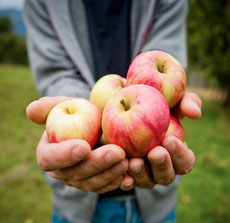| « Previous | News | Next » |
May 05, 2014
Ciders for Spring & Summer
 Hard cider has a long history in America, dating back to the Colonial period when it was the most popular beverage in the country. It made its way here with the English settlers, who soon learned that apples were much easier to grow in the New England soil than the barley and grains for beer. By the turn of the 18th century, Americans were drinking an average of 35 gallons of cider per year. There was even a weakened version called Ciderkin for children.
Hard cider has a long history in America, dating back to the Colonial period when it was the most popular beverage in the country. It made its way here with the English settlers, who soon learned that apples were much easier to grow in the New England soil than the barley and grains for beer. By the turn of the 18th century, Americans were drinking an average of 35 gallons of cider per year. There was even a weakened version called Ciderkin for children.
But its heyday didn’t last—and the Midwest is partly to blame. When brewers discovered that the Midwest’s soil was prime for growing barley and grains, beer took off. Plus, a new wave of beer-thirsty immigrants, and, later, Prohibition didn’t help matters any for the humble cider.
Cream carries handcrafted, delicate ciders that will grace the table with as much panache as many a wine. The care and vision involved in each bottle warrants a serious revisiting of this genre that was so popular with our forefathers.
Over the last 25 years, cider has come back with a vengeance—and not just in America. The French, Italians, and Spanish are churning out sophisticated and exciting versions. In Normandy, sommelier-turned-farmer Eric Bordelet makes artisan ciders from heirloom apple and pear trees. He organically farms and handpicks 20 varieties of apples and 14 of pears for complexity and balance. The Art of Eating wrote in issue #87, “his ciders are on a higher level than most others in the region; they have concentration, focus, balance, finesse and, above all, delicious flavors of ripe apples and subtle spice.” (read article here) His Nouvelle Vague is light, refreshing, and pairs beautifully with apple tarte tatin. Try his Brut Tendre with a ham and Gruyere crepe. His Argelette is a premium cider that exudes apricot, lemon, honey, and mild spice, definitely suited to drinking alongside cheese.
 In the Alpine Italian region of Valle d’Aosta, the Maley Cider Project (new to our portfolio; talk with your Cream Rep about pricing and availability) makes cider in the both the Methode Traditionelle (or Champenoise method) and Methode Ancestral (using all indigenous yeast). The century-old orchards in the region generate fruits surprisingly adapted to produce cider, with suitable characteristics of acidity, tannins, and sugar concentration. We carry a version of each with characteristics of apple and white blossom aromas and the grace to accompany rich fondue as a refreshing counterpoint.
Maley Apple Cider Jorasses Methode Traditionelle
Maley Cidre du Mont Blanc Methode Ancestral
In the Alpine Italian region of Valle d’Aosta, the Maley Cider Project (new to our portfolio; talk with your Cream Rep about pricing and availability) makes cider in the both the Methode Traditionelle (or Champenoise method) and Methode Ancestral (using all indigenous yeast). The century-old orchards in the region generate fruits surprisingly adapted to produce cider, with suitable characteristics of acidity, tannins, and sugar concentration. We carry a version of each with characteristics of apple and white blossom aromas and the grace to accompany rich fondue as a refreshing counterpoint.
Maley Apple Cider Jorasses Methode Traditionelle
Maley Cidre du Mont Blanc Methode Ancestral
Looking for a pétillant naturel cider? Jean-Yves Peron has produced a cider that feels like an orchard in your mouth…apple skins, complex, clean acid. Try his ‘Cidre des Cimes’ with Savoie cheese while picnicking.
Stateside, in Santa Cruz, California, Bonny Doon makes ‘Querry’ Cider: a bone-dry apple, pear, and quince cider that is produced with indigenous yeast and has crisp acidity and bold aromatics that match Asian food.
